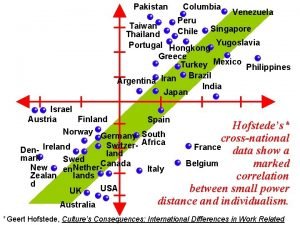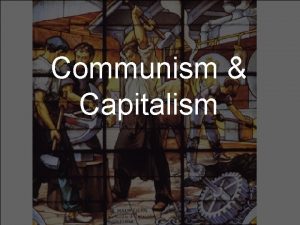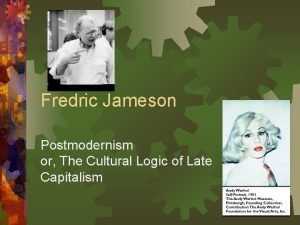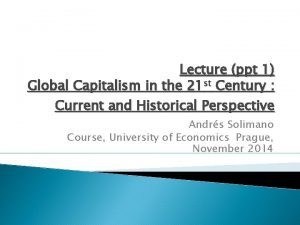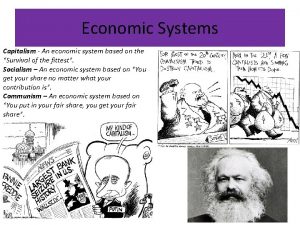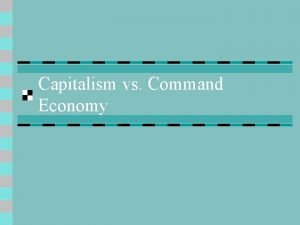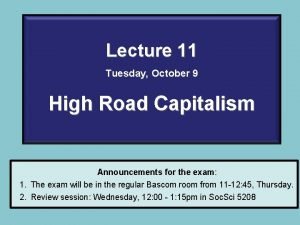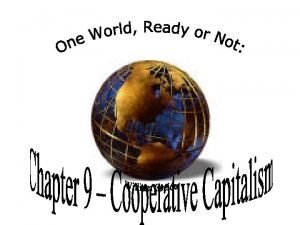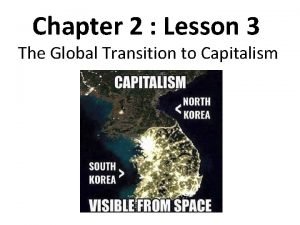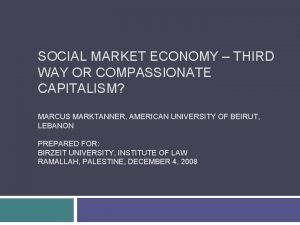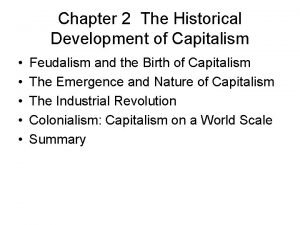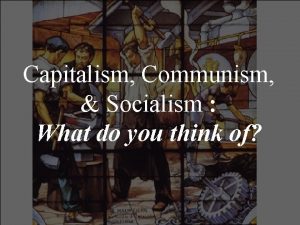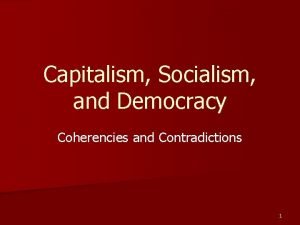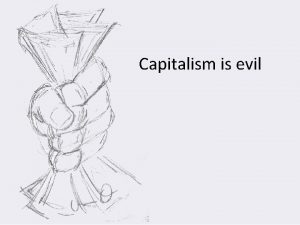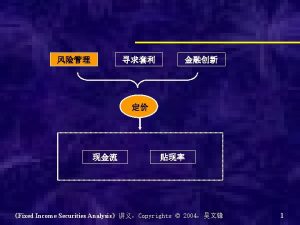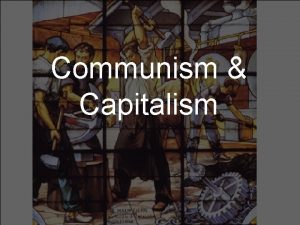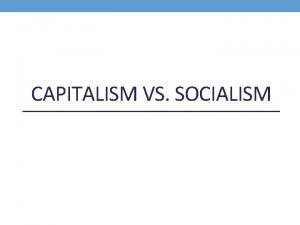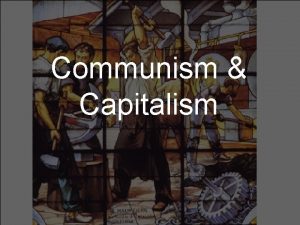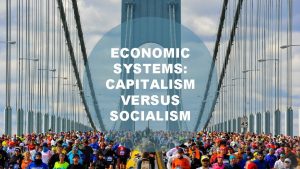EXPERIMENT AFTER EXPERIMENT RETURN OF CAPITALISM INTO POSTSOVIET


























































- Slides: 58

EXPERIMENT AFTER EXPERIMENT RETURN OF CAPITALISM INTO POST-SOVIET UKRAINE AND EASTERN EUROPE Mykhailo Minakov Associate Professor, Dep. of Philosophy, University of Kyiv-Mohyla Academy Public lecture at the European University Institute March 16, 2015, Florence

PRIMARY QUESTIONS • What is the social experiment and what impact does it make upon modern society? • What was the social experiment in Soviet Union, and how did it influenced post-Soviet nations? • What kind of capitalism do we have in Ukraine and in other post-Soviet Eastern European nations?

LECTURE’S OUTLINE 1. What is a social experiment? 2. What were the major features of the Soviet experiment? 3. What are the major features of the post-Soviet social experiments with capitalism and democracy? 4. Eastern Europe and its sources of its conflicts

1. SOCIAL EXPERIMENTS • Experiments with History • Vladimir Lenin: speeding up to the state of communism, End of History? • Late Soviet Intellectuals: Return of NORMAL History? • Industrial Modernity and Social Engineering

1. SOCIAL EXPERIMENTS : SOCIAL ENGINEERING Industrial logic of bettering society • Ferdinand Tönnies (Germany, 1890 s): in order to get best results of social development societies must become scientific systems using contemporary technologies • J. C. Van Marken (Netherlands, 1894) and William H. Tolman (USA, 1909): a discipline to handle human problem in the era of industrial development • Karl Popper (The Open Society and Its Enemies): ‘Utopian social engineering’ vs ‘piecemeal social engineering’

1. SOCIAL EXPERIMENTS : SOCIAL ENGINEERING Cultural trauma in a result of social engineering • Hannah Arendt (The Origins of Totalitarianism, p. 12): totalitarian experiments’ broke the cultural continuity and made the late Modernity to be a source of meaninglessness of our moral and political values’ • Jurgen Habermas (The Theory of Communicative Action, 1984 and 1987): Colonisation of the lifeworld is the process by which individual freedom is undermined in complex societies when large-scale social processes become increasingly autonomous and restrict the actions of those who are subject to them

1. SOCIAL EXPERIMENTS : CAPITALISM an economic system that is based on private ownership of capital goods and the means of production, and the creation of goods and services for profit • institutional set up: • private property and free market • political regime supporting the two above • the legitimation and cultural systems which generate meanings and values for members of the capitalist society • humans having capacity to make these institutes working

1. SOCIAL EXPERIMENTS : SOCIALISM an economic system with publically owned means of production and social control of the wealth distribution, and the following institutional set up: • a set of collectivist values and norms putting ahead equality, solidarity and public property reproducing itself through certain social order, political regime and the legitimation and cultural systems • humans having capacity to make these institutes working

1. SOCIO-POLITICAL EXPERIMENT • Socio-political experiment is a radical case of social engineering aiming to implement Utopian aims supported/articulated by social theories and totalitarian ideologies of late Modernity • Socio-political experiments are directly connected with the attempt of ‘system’ to control the construction and application of norms by life-world • The change brought by experiments is connected with direct targeting of popular norms, values and practices

1. SOCIAL EXPERIMENTS : COMPARISON The both value sets represent different models of Modernity and define separation of public and private spheres differently • The Tab. 1 represents ‘capitalist’ Modernity tending to clearly separate and balance the both spheres • The Tab. 2 represents ‘socialist’ Modernity with structural misbalance between private and public

1. SOCIAL EXPERIMENTS : IDEAL CAPITALIST MODERNITY Public Sphere government judiciary parliament parties civil society business privacy of individual family religious organizations Private Sphere

1. SOCIAL EXPERIMENTS : IDEAL SOCIALIST MODERNITY Public Spheregovernment judiciary parliament privacy of individual parties civil society business family religious organizations Private Sphere

1. SOCIAL EXPERIMENTS : MODERNITY AND ITS VALUES Capitalism is an economic system that is based on private ownership of capital goods and the means of production, and the creation of goods and services for profit • institutional set up: • private property and free market • political regime supporting the two above • humans having capacity to make these institutes working • Modernity: constitutional order of public and private dichotomy

1. SOVIET EXPERIMENT • a conscious attempt of rulers to change societies and cultures of peoples living in USSR with the use of Utopian-revolutionary theories (scientific socialism of K. Marx and F. Engels, as well as Lenin’s idea of establishing socialism in one separate country) • ideological dogmatism: aims and tools of development are provided by scientific socialism, not local need • Soviet experiment is based on the elites’ acceptance of socialist ideological hypothesis for a final truth

1. POST-SOVIET EXPERIMENTS • a conscious attempt of elites to change societies and cultures of peoples living in USSR with the use of radical liberal theories and ethnonationalist beliefs • ideological dogmatism: aims and tools of development are provided by economic liberalism and political nationalism, not local need in a given moment • post-Soviet experiment is based on the elites’ acceptance of capitalism for a natural human condition

1. HYPOTHESIS Even though the both above models are ideal types having their meaning in terms of social science and philosophy, I argue that, • in the context of Soviet and post-Soviet political cultures, these ideal types of western Modernity and capitalism were perceived by the power elites as aims legitimizing their rule • having them as the ideal ends needed to be established in social reality with the use of radical social engineering (sociopolitical experimentation), power elites disregarded existing complex of social and economic needs • the end result of those experiments with Modern aims paradoxically led to de-modernization of the Soviet and post. Soviet societies, leading to high risks of wars and ethnic clashes

1. HYPOTHESIS the Soviet and post-Soviet socio-political experiments were undertaken by political groups using government institutions to make the radical change expecting ‘to return’ to ‘natural state’ of cultural, economic and political spheres to prove that post-Soviet political regimes in 1990 -es had features of socio-political experimentation, I propose to compare the change in those three spheres at individual and institutional levels of development: • economy • political organization • cultural identities

2. SOVIET EXPERIMENT • leading principles: undivided public and private, political and economic • state terror with the living populations, promised social justice after elimination of classes • Soviet modernization: annihilation of Life-World (both, traditions and their bearers)

2. SOVIET EXPERIMENT • institutions: • totalitarian institutional set-up (1928 -60 ies) • public property with some sector of personal property: no privacy • nomenclatura and one party-system • parity of codified and un-codified rules • humans: • class identity vs ethnic identity (final solution of nationality question) • educated obedience (democides, GULag, schooling, censorship), official ideology and cynical response • doublethink: personal morality vs public indifference

2. RESULTS OF SOVIET EXPERIMENT Soviet Institutions • political and governance traditions of ‘state as problem’, etatism • neither politics, nor economy • absent norms for political and economic competition Soviet Human • educated hatred to values grounding capitalism • doublethink and dysfunction of official ideology • educated collectivism and deviant individualism • educated obedience and dependency

COLLAPSE OF USSR AND CREATION OF INDEPENDENT UKRAINE

3. THE POST-SOVIET EXPERIMENTS ‘CAPITALIST’ REVOLUTIONARIES guiding ideas of 1991 revolution • return to Europe • just another normativity: build ‘normal society’ • transform state and economy into ‘Western’ ones • freedom of political and economic imagination

3. EXPERIMENT AFTER EXPERIMENT’S DIMENSIONS • revived 1917 -21 in quest for new grounds of legitimacy: reference to past in spite of huge cultural changes by end of 20 th century • quest for plenty and stability: privatization in societies where entrepreneurship was long a criminal activity • quest for optimal government: democratization without institutional support

3. NEW EXPERIMENTS AND PARTING WAYS : EARLY 1990 IES • Ukraine and Moldova: national-communist rule with dialogue with national-democrats • Russia: moderate democratic and radical economic reforms • the Baltic countries: radical democratic and economic reforms • Belarus: Soviet regime reestablished • Caucasus: ethnic wars followed by façade-democratic regimes • Central Asia: national communists lead refeudalization/tribalization

3. INSTITUTIONAL CHANGE • creation of private owners • opening autarchic economies • national statehood • political pluralism and competition

3. ECONOMIC ‘NORMALIZATION’ • Governmental strategies: • deregulated prices, prohibited subsidies and eliminated monopolies • hyperinflation to be put under control of Min. Fin and independent Centro. Bank • looking for owners of the public enterprises: large-scale privatization • Rent seekers’ strategies: • making money on transitional market distortions • control over government • Population’s strategy: • survival in chaos, private entrepreneurs without skills • new clientele networks

3. POST-SOVIET EXPERIMENTATION • creation of private owners : oligarchy • open economies : export oriented economies • national statehood : government-led invention of identities • political competition : parties as business or fanorganizations, problematic citizenship and representation

ECONOMIC ‘NORMALIZATION’ • Governmental strategies: • deregulated prices, prohibited subsidies and eliminated monopolies • hyperinflation to be put under control of Min. Fin and independent Centro. Bank • looking for owners of the public enterprises: large-scale privatization • Rent seekers’ strategies: • making money on transitional market distortions • control over government • Population’s strategy: • survival in chaos, private entrepreneurs without skills • new clientele networks Aslund How Capitalism Was Built, p. 62.

PERESTROIKA 1986 - 1991 DISSOLVING THE ORDER • growth of shadow economy • entrepreneurs as criminals • booming bazaar culture • cooperative movement • economic crisis

3. ECONOMIC ‘NORMALIZATION’ ECONOMIC CRISIS IN 1992 -1997 • Governmental strategies: • deregulated prices, prohibited subsidies and eliminated monopolies • hyperinflation to be put under control of Min. Fin and independent Centro. Bank • looking for owners of the public enterprises: large-scale privatization • Rent seekers’ strategies: • making money on transitional market distortions • control over government • Population’s strategy: • survival in chaos, private entrepreneurs without skills • new clientele networks Aslund How Capitalism Was Built , p. 60.

3. ECONOMIC ‘NORMALIZATION’ SURVIVAL ECONOMY • Governmental strategies: • deregulated prices, prohibited subsidies and eliminated monopolies • hyperinflation to be put under control of Min. Fin and independent Centro. Bank • looking for owners of the public enterprises: large-scale privatization • Rent seekers’ strategies: • making money on transitional market distortions • control over government • Population’s strategy: • survival in chaos, private entrepreneurs without skills • new clientele networks Aslund How Capitalism Was Built, p. 66.

3. POLITICAL ‘NORMALIZATION’ • ideological transition: ethnonationalism - social democracy - liberalism • demand for order and a need in new safety net within former Soviet administrative borders • problematic separation of public and private spheres • transformation of regimes into democracies (of different types) • oligarchy and plutocracy: prolongation of transition • deficit of citizens and dysfunctional civil society

POLITICAL ‘NORMALIZATION’ • ideological transition: ethnonationalism - social democracy - liberalism ethnonationalism • demand for order and a need in new safety net within former Soviet administrative borders • problematic separation of public and private spheres • transformation of regimes into democracies (of different types) • oligarchy and plutocracy: prolongation of transition • deficit of citizens and dysfunctional civil society


RETURN OF CAPITALISM : NEW IDENTITIES • invention of ethnic within the Soviet administrative borders • prohibition of the Soviet identity • ethnocracy projects • the Baltic states: regimes for the non-citizens • Belarusian reaction: Lukashenka regime • slow invention of selves: Kazakhstan and Ukraine

RETURN OF CAPITALISM : NEW IDENTITIES • invention of ethnic within the Soviet administrative borders • prohibition of the Soviet identity • ethnocracy projects • the Baltic states: regimes for the non-citizens • Belarusian reaction: Lukashenka regime • slow invention of selves: Kazakhstan and Ukraine

POLITICAL ‘NORMALIZATION’ • ideological transition: ethnonationalism - social democracy - liberalism ethnonationalism • demand for order and a need in new safety net within former Soviet administrative borders • problematic separation of public and private spheres • transformation of regimes into democracies (of different types) • oligarchy and plutocracy: prolongation of transition • deficit of citizens and dysfunctional civil society

PRIVATIZATION economic reforms: • price liberalization, hyperinflation, arbitrage opportunities • mass privatization • voucher privatization • local elites gains

POLITICAL ‘NORMALIZATION’ • ideological transition: ethnonationalism - social democracy - liberalism ethnonationalism • demand for order and a need in new safety net within former Soviet administrative borders • problematic separation of public and private spheres • transformation of regimes into democracies (of different types) • oligarchy and plutocracy: prolongation of transition • deficit of citizens and dysfunctional civil society Aslund How Capitalism Was Built, p. 169.

POLITICAL ‘NORMALIZATION’ • ideological transition: ethnonationalism - social democracy - liberalism ethnonationalism • demand for order and a need in new safety net within former Soviet administrative borders • problematic separation of public and private spheres • transformation of regimes into democracies (of different types) • oligarchy and plutocracy: prolongation of transition • deficit of citizens and dysfunctional civil society

POLITICAL ‘NORMALIZATION’ • ideological transition: ethnonationalism - social democracy - liberalism ethnonationalism • demand for order and a need in new safety net within former Soviet administrative borders • problematic separation of public and private spheres • transformation of regimes into democracies (of different types) • oligarchy and plutocracy: prolongation of transition • deficit of citizens and dysfunctional civil society

POLITICAL ‘NORMALIZATION’ • ideological transition: ethnonationalism - social democracy - liberalism ethnonationalism • demand for order and a need in new safety net within former Soviet administrative borders • problematic separation of public and private spheres • transformation of regimes into democracies (of different types) • oligarchy and plutocracy: prolongation of transition • deficit of citizens and dysfunctional civil society Aslund How Capitalism Was Built, p. 185.

WISDOM OF ‘WILD 1990 -S’: KARL MARX WAS WRONG ABOUT SOCIALISM, BUT HE WAS DAMN RIGHT ABOUT CAPITALISM

4. POST-SOVIET (DE)MODERNIZATION • Cycles of Modernity in Eastern Europe: modernist motivations – modernist socio-political project – neotraditionalist reaction – authoritarian solution – crisis and new raise of modernist motivations • De-modernization as part of cycle • Resource economies and adequacy of elites • Ukraine : Soviet industrial legacy as resource for economy + elites capable of managing this legacy = demodernizing society • Russia : (A. Etkind) Petrostate + elites capable of delivering oil to far-away consumers = demodernizing society

4. DEMOCRACY VS AUTOCRACY : 2010+ • democratic regimes with market economies: the Baltic countries • façade democracies with unstable political and economic pluralism: Ukraine, Armenia, Georgia, Moldova, and Kyrgyzstan • mild authoritarian regimes with economies favoring rentseekers: Kazakhstan and Tajikistan • authoritarian regimes: Azerbaijan, Belarus, Russia, Turkmenistan and Uzbekistan

4. POST-SOVIET HUMAN • money value and consumer society • distrust and social fragmentation • conflicting individualism • new interest in collectivism and irrationalism : radical nationalism and conservatism • depopulation • lost in transition


PERESTROIKA 1986 - 1991 DISSOLVING THE ORDER • growth of shadow economy • entrepreneurs as criminals • booming bazaar culture • cooperative movement • economic crisis

POST-SOVIET HUMAN ON USSR COLLAPSE source: The Pulse of Europe 2009: 20 Years After the Fall of the Berlin Wall

POST-SOVIET HUMAN ON USSR COLLAPSE source: The Pulse of Europe 2009: 20 Years After the Fall of the Berlin Wall

4. REGION OF CONFLICTS • destroyed intercultural communication and growing importance of ethnic identities : hostile elites and neighboring populations • a belt of unrecognized states • unstable democracies VS stable authoritarianisms • Russian anti-Westernism and Eurasian project • Putin’s integration projects in the Eastern Europe


CHAIN OF EASTERN EUROPEAN AUTHORITARIANISMS • Promise of 1991 – democratic freedom and free-market welfare • disorientation of 1990 ies: romantic nationalism and criminal pragmatism • forgotten aims of revolutionary 1991 • 2004 – 2005 : Orange Revolution • 2013 – 2014 : Euromaidan

CHAIN OF EASTERN EUROPEAN AUTHORITARIANISMS • War of many dimensions: civil, Russo-Ukrainian, Soviet, Russia – West etc. • unfinished state-building, inefficient state • developed oligarchic groups controlling public posts, civic organizations, mass media etc. • overcentralized government with Soviet administrativeterritorial structure • absent attention to democratic institutes and private sector

INTERIM CONCLUSIONS : OSTMODERNISM • Post-Soviet political imagination did not lead to capitalist modernization : experiments of 1990 -s fail in f. SU countries – Ukrainian crisis is just beginning • questionable legitimacies of political regimes brought back Soviet and pre-Soviet traditions • new sub-regional political projects • future as a source of radical traditionalism • agenda of 1991 is back for Ukraine and entire region : transition again with no final point but with lessons learned

INTERIM CONCLUSIONS • What is the social experiment and what impact does it make upon modern society? Modernization with cycles of modern attempts and neo-traditionalist results. • How did Soviet social experiment it influenced post. Soviet nations? Hybrid institutions that ensure cycles of (de)modernization. • What kind of capitalism do we have in Ukraine and in other post-Soviet Eastern European nations? Capitalism as it was imagined by late Soviet generation with conflicting individualism, resource economies and oligarchic rule.

THANK YOU FOR YOUR ATTENTION! GRAZIE PER L’ATTENZIONE!

KEY LITERATURE • Arendt, Hannah (1973) The Origins of Totalitarianism, New York, Harcourt Brace Jovanovich • Aslund, Anders (2007) How Capitalism Was Built, Cambridge University Press • Habermas, J. (1984, 1987) Theory of Communicative Action, Vol 2. , Boston, Mass. : Beacon Press • Habermas, Jürgen (1989) The Structural Transformation of the Public Sphere: An Inquiry into a category of Bourgeois Society, Cambridge, Polity • Malia, Martin (1994) The Soviet Tragedy: A History of Socialism in Russia, 1917 -1991, NY, Free Press • Marx, K. , Engels, F. (1947) Manifesto of The Communist Party, NY, International Publishers • Östlund, David (2007) A knower and friend of human beings, not machines: The business career of the terminology of social engineering, 1894 -1910, Ideas in History, Vol. 2, 43 -82. • Popper, K. 1971 The Open Society and Its Enemies Princeton, New Jersey: Princeton University Press. • Suny, Ronald (2010) The Soviet Experiment: Russia, the USSR, and the Successor States, NY-Oxford, Oxford University Press • Tönnies, Ferdinand (2009) The Present Problems of Social Structure, 1905, Gesamtausgabe, Berlin/New York, Walter de Gruyter, B. 7, p. 269 -285. • Зубов, Андрей, ред. (2010) История России, ХХ век, в 2 х томах, Москва, МШПИ • Попович, Мирослав (2007) Червоне століття, Київ, Універс
 After me after me after me
After me after me after me After me after me after me
After me after me after me After the experiment scientists organize and the data
After the experiment scientists organize and the data Working conditions during the industrial revolution
Working conditions during the industrial revolution Capitalism versus communism
Capitalism versus communism Consumer capitalism
Consumer capitalism Feudalism vs communism
Feudalism vs communism Free enterprise lesson
Free enterprise lesson Father of capitalism
Father of capitalism Jameson postmodernism
Jameson postmodernism Capitalism communism socialism fascism
Capitalism communism socialism fascism Traits of capitalism
Traits of capitalism Components of capitalism
Components of capitalism Global capitalism ppt
Global capitalism ppt Characteristics of capitalism
Characteristics of capitalism Mercantilism vs capitalism
Mercantilism vs capitalism Slaughter academic capitalism download
Slaughter academic capitalism download Capitalism conclusion
Capitalism conclusion Capitalism disadvantages
Capitalism disadvantages Casino capitalism definition
Casino capitalism definition Capitalism vs command economy
Capitalism vs command economy Communism and capitalism dbq answer key
Communism and capitalism dbq answer key Modified free enterprise economy
Modified free enterprise economy Rock paper scissors communist game
Rock paper scissors communist game Capitalism communism socialism fascism
Capitalism communism socialism fascism Capitalism communism socialism fascism
Capitalism communism socialism fascism Capitalist economic system
Capitalist economic system Socialism capitalism communism fascism
Socialism capitalism communism fascism Low road capitalism
Low road capitalism Pros and cons of capitalism
Pros and cons of capitalism Characteristics of capitalism
Characteristics of capitalism Pros and cons of capitalism
Pros and cons of capitalism Capitalism pros and cons
Capitalism pros and cons Capitalism kritik
Capitalism kritik The american free enterprise system lesson 1 answer key
The american free enterprise system lesson 1 answer key Mercantilism vs capitalism
Mercantilism vs capitalism Capitalism ideas
Capitalism ideas Was the cold war capitalism vs communism
Was the cold war capitalism vs communism Communism is better than capitalism pros and cons
Communism is better than capitalism pros and cons Karl marx theory
Karl marx theory Moore law wall streetjournal
Moore law wall streetjournal Lesson 3 the global transition to capitalism answer key
Lesson 3 the global transition to capitalism answer key Reviewing key terms
Reviewing key terms Socialism and capitalism in an inspector calls bbc bitesize
Socialism and capitalism in an inspector calls bbc bitesize Communism
Communism Compassionate capitalism definition
Compassionate capitalism definition Development of capitalism
Development of capitalism What is a communism government
What is a communism government The inherent vice of capitalism
The inherent vice of capitalism Benefits of capitalism
Benefits of capitalism Traditional capitalism
Traditional capitalism What is the basic principle of pronoun antecedent agreement
What is the basic principle of pronoun antecedent agreement Mug #12 answers
Mug #12 answers Boxed soffit
Boxed soffit Purchase return book
Purchase return book Mean absolute deviation math is fun
Mean absolute deviation math is fun Crossover rate calculator
Crossover rate calculator Wbcomtax p tax
Wbcomtax p tax Analisa produksi
Analisa produksi





